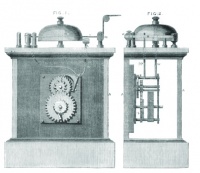Today’s fire alarms and smoke detectors are incredibly sensitive devices, frequently triggered by little more than an over-cooked baked potato or a burnt slice of toast. While 19th century home dwellers were spared these modern irritations, house fires were an ever-present threat and this article from the archives proposes an elegant Victorian solution to the problem.

The article describes ’a peculiar application of a fusible wire or cord connected with the several rooms of a house, parts of a ship or other place, and attached to a suitable alarum, in such a manner as when acted upon by heat it will be dissolved or melted, by which the train of the wheels connected with the hammer and the bells is liberated and the alarm given’.
“When acted upon by heat the wire will be dissolvedor melted”
The Engineer continued: ’The patentee observes that in applying this invention to the several rooms of a house one method he should adopt would be to convey a wire from the lever through the pulley along passages, mouldings, cornices, floors, ceilings, above or below ground, in any convenient manner, by cranks, joints, or pulleys and in each room or other place introduce short lengths of the fusible wire or cord already described, so that the heat of any room through which the wire passes rising to a temperature sufficient to dissolve or melt the same, the continuous line would be broken and liberate the lever which will, in consequence of the spring, allow the hammer to strike the bell, by which the alarm would be given.’
Although an intriguing idea, the article doesn’t shed any light on whether the device was ever actually commercialised.




Swiss geoengineering start-up targets methane removal
No mention whatsoever about the effect of increased methane levels/iron chloride in the ocean on the pH and chemical properties of the ocean - are we...